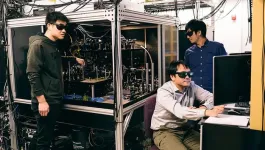(Press-News.org) The atmosphere, the ocean and life on Earth interacted over the past 500-plus million years in ways that improved conditions for early organisms to thrive. Now, an interdisciplinary team of scientists has produced a perspective article of this co-evolutionary history published in multidisciplinary open-access journal National Science Review (Oxford University Press, Impact Factor 20.7).
“One of our tasks was to summarize the most important discoveries about carbon dioxide and oxygen in the atmosphere and ocean over the past 500 million years,” says Syracuse University geochemistry professor Zunli Lu, lead author on the paper. “We reviewed how those physical changes affected the evolution of life in the ocean. But it’s a two-way street. The evolution of life also impacted the chemical environment. It is not a trivial task to understand how to build a habitable Earth over long time scales”
The team from Syracuse University, Oxford University and Stanford University explored the intricate feedbacks among ancient life forms, including plants and animals, and the chemical environment in the current Phanerozoic Eon, which began approximately 540 million years ago.
At the start of the Phanerozoic, carbon dioxide levels in the atmosphere were high, and oxygen levels were low. Such a condition would be difficult for many modern organisms to thrive. But ocean algae changed that. They absorbed carbon dioxide from the atmosphere, locked it into organic matter and produced oxygen through photosynthesis.
The ability of animals to live in an ocean environment was affected by oxygen levels. Lu is studying where and when ocean oxygen levels may have risen or fallen during the Phanerozoic using geochemical proxies and model simulations. Co-author Jonathan Payne, professor of Earth and planetary sciences at Stanford University, compares an ancient animal’s estimated metabolic requirements to places where it survived or disappeared in the fossil record.
As photosynthetic algae removed atmospheric carbon into sedimentary rocks to lower carbon dioxide and raise oxygen levels, the algae’s enzymes became less efficient in fixing carbon. Therefore, algae had to figure out more complicated ways of doing photosynthesis at lower carbon dioxide and higher oxygen levels. It accomplished this by creating internal compartments for photosynthesis with control over the chemistry.
“For algae, it is changes in the environmental ratio of O2/CO2 that seems to be key to driving improved photosynthetic efficiency,” says co-author Rosalind Rickaby, who is a professor of geology at Oxford. “What is really intriguing is that these improvements in photosynthetic efficiency may have expanded the chemical envelope of habitability for many forms of life.”
Ancient photosynthesizers had to adapt to changes in the physical environment that they themselves had created, notes Lu. “The first part of the history of the Phanerozoic is increasing habitability for life, and then the second part is adaptation.”
If scientists want to further understand this interplay between life and the physical environment, as well as the drivers and limits on habitability, the authors suggest that mapping out the spatial patterns of ocean oxygen, biomarkers for photosynthesis and metabolic tolerance of animals shown in fossil records will be a key future research direction.
END
Scientists untangle interactions between the Earth’s early life forms and the environment over 500 million years
2024-07-29
ELSE PRESS RELEASES FROM THIS DATE:
UAB study reveals link between transthyretin levels and heart disease risk
2024-07-29
Physician-scientists from the University of Alabama at Birmingham Marnix E. Heersink School of Medicine have uncovered significant findings regarding the impact of transthyretin, or TTR, protein levels on heart disease risk. The study, recently published in Nature Communications, explores how variations in TTR levels are associated with adverse clinical outcomes, providing new insights into the prevention and management of amyloid heart disease. Transthyretin is a transport protein produced in the liver, and its misfolding is linked to the development of cardiac amyloidosis, a condition that leads to heart failure and increased mortality.
The study, led ...
MicroRNA study sets stage for crop improvements
2024-07-29
MEDIA INQUIRES
WRITTEN BY
Laura Muntean
Ashley Vargo
laura.muntean@ag.tamu.edu
601-248-1891
FOR ...
Semaglutide may show promise for smoking cessation
2024-07-29
Embargoed for release until 5:00 p.m. ET on Monday 29 July 2024
Annals of Internal Medicine Tip Sheet
@Annalsofim
Below please find summaries of new articles that will be published in the next issue of Annals of Internal Medicine. The summaries are not intended to substitute for the full articles as a source of information. This information is under strict embargo and by taking it into possession, media representatives are committing to the terms of the embargo not only on their own behalf, but also ...
Self-powered ’bugs’ can skim across water to detect environmental data
2024-07-29
INGHAMTON, N.Y. -- Researchers at Binghamton University, State University of New York have developed a self-powered “bug” that can skim across the water, and they hope it will revolutionize aquatic robotics.
Futurists predict that more than one trillion autonomous nodes will be integrated into all human activities by 2035 as part of the “internet of things.” Soon, pretty much any object — big or small — will feed information to a central database without the need for human involvement.
Making this idea tricky is that 71% of the Earth’s ...
NASA data shows July 22 was Earth’s hottest day on record
2024-07-29
July 22, 2024, was the hottest day on record, according to a NASA analysis of global daily temperature data. July 21 and 23 of this year also exceeded the previous daily record, set in July 2023. These record-breaking temperatures are part of a long-term warming trend driven by human activities, primarily the emission of greenhouse gases. As part of its mission to expand our understanding of Earth, NASA collects critical long-term observations of our changing planet.
“In a year that has been the hottest on record to date, these past two weeks have ...
Prestigious NIH award will advance brain research at UCR
2024-07-29
RIVERSIDE, Calif. -- A National Institutes of Health grant received by Vijayalakshmi (Viji) Santhakumar, a professor of molecular, cell and systems biology at the University of California, Riverside, has been selected for the prestigious Javits Neuroscience Investigator Award, the first time for the campus.
The five-year, $3.5 million grant from the National Institute of Neurological Disorders and Stroke, or NINDS, of the National Institutes of Health is a collaborative study with Edward Zagha, an associate professor of psychology at UCR. The award will support research into how brain circuits contribute to episodic memory formation and how ...
Purdue researchers trap atoms, forcing them to serve as photonic transistors
2024-07-29
Researchers at Purdue University have trapped alkali atoms (cesium) on an integrated photonic circuit, which behaves like a transistor for photons (the smallest energy unit of light) similar to electronic transistors. These trapped atoms demonstrate the potential to build a quantum network based on cold-atom integrated nanophotonic circuits. The team, led by Chen-Lung Hung, associate professor of physics and astronomy at the Purdue University College of Science, published their discovery in the American Physical Society’s Physical Review X.
“We developed a technique to use lasers ...
Analogies for modeling belief dynamics
2024-07-29
Researchers who study belief dynamics often use analogies to understand and model the complex cognitive–social systems that underly why we believe the things we do and how those beliefs can change over time. Ideas can be transmitted like a virus, for instance, “infecting” a population as they spread from person to person. We might be drawn — like magnets — to others with a similar worldview. A society’s beliefs can shift slowly before reaching a tipping point that thrusts society into a new phase.
In a new paper in Trends in Cognitive Sciences, SFI Professor Mirta Galesic and ...
Many juvenile ‘lifers’ freed
2024-07-29
In 1953, 15-year-old Joe Ligon and four other Pennsylvania teens went on an alcohol-fueled tear that resulted in the stabbing deaths of two people and injuries to six more.
The teens were tried as a group, and all received life without parole.
After a series of U.S. Supreme Court decisions in 2012 and 2016 found that mandatory life sentences for juveniles was unconstitutional, Ligon’s case went to federal court. After 67 long years in prison, the case was decided in his favor in 2020.
Ligon was granted his freedom in 2021 — at 83 years of age and after ...
UW model shows cortical implants like Elon Musk’s Blindsight unlikely to ‘exceed normal human vision’
2024-07-29
Elon Musk recently declared on X that Blindsight, a cortical implant to restore vision, would have low resolution at first “but may ultimately exceed normal human vision.”
That pronouncement is unrealistic at best, according to new research from the University of Washington.
Ione Fine, lead author and UW professor of psychology, said Musk’s projection for the latest Neuralink project rests on the flawed premise that implanting millions of tiny electrodes into the visual cortex, the region of the brain that processes information received from the eye, will result in high-resolution vision.
For the study, ...




